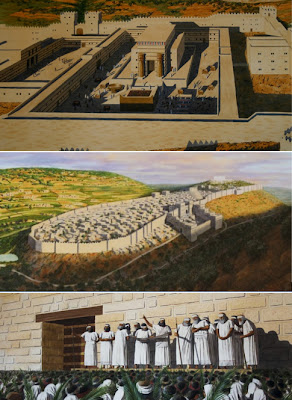I received an interesting comment
from a reader recently, in which he said, “As the Nephites did not build with stone, but with wood, we
should not expect to find stone structures in Nephite cities. So the absence of
stone buildings, stone walls and monumental pyramids is an argument in favor of
a site’s authenticity, not the other way around”
Huey D.
Since there have been
several comments received that the Nephites did not build in stone, but
only in wood, it seemed a subject that needed discussion in a complete post.
First of all, one
might wonder what Moroni, who labored with his army to build stone
fortifications “all around the land,” would say to that statement that the
Nephites never built out of stone, but only wood: “he had been strengthening the armies of the Nephites, and erecting
small forts, or places of resort; throwing up banks of earth round about to
enclose his armies, and also building walls of stone to encircle them about,
round about their cities and the borders of their lands; yea, all round about
the land” (Alma 48:8). Did we all get that? "building walls of stone to encircle them about,
round about their cities and the borders of their lands; yea, all round about
the land."
One of the questions
about this Book of Mormon statement no one seems to ask is: “Why did the Nephites know how to build
stone fortification walls “round about their cities and the borders of their
land”? Would this have been a unique event? Moroni, wanting to defend his country
against constant Lamanite attacks, suddenly decides, at a most critical moment
in his history, that his army should build stone
fortifications when nothing else had ever been built in stone by them? Why would he think they could build in stone? What experience did he
or they have building with stone, and in such a manner as to defend themselves
against an invading army? These would not have been some amateurish stacked
stone walls—they would have to be sturdy enough to stop a very large army, men
who knew how to fight and who wanted to kill every Nephite in the land.
It would seem more logical
to assume that the Nephites were used to building with stone, and would have
been doing so for quite some time, than to think that Moroni suddenly trust in
stone building to protect his nation, of which he had the sole responsibility
for that.
Where would this
knowledge of building in stone have come? Why would Nephites know how to build
in stone?
The fact is, Nephi
and Sam would have known all about stone buildings, which the Israelites of
Jerusalem had spent centuries building before Lehi left Jerusalem. They certainly
knew about the stone temple Solomon built in the mid-10th century
B.C., which was both a draw to people from far off lands, and also was known
enough to Nephi for him to compare his own temple building to it (2 Nephi 5:16).
Top: Solomon’s stone built Temple Complex
dated to 960 B.C.; Center: A stone wall completely surrounds the entire city
with several extensions. This is the city Nephi and Sam would have known;
Bottom: Assembled
at the water gate (Nehemiah 8:3) Ezra makes a public reading of the Torah after
returning from Babylonian exile in 443 B.C. According to Eilat Mazar, the gate was part of the original 10th
century B.C. temple
In addition, Nephi
and Sam certainly would have known about and seen on numerous occasions, the
walls around the city of Jerusalem (1 Nephi 4:4-5, 27), and obviously
understood their defensive significance. When building his own city in the Land
of Promise, one can only wonder why anyone thinks he would have built defensive
walls of destructible wood, rather than the indestructible stone with which he
was far more familiar.
When Nephi wrote: “I
did teach my people to build buildings, and to work in all manner of wood, and
of iron, and of copper, and of brass, and of steel, and of gold, and of silver,
and of precious ores, which were in great abundance” (2 Nephi 5:15), it should
not be construed to mean that he built everything out of wood any more than we
can suggest he built everything out of iron or copper or brass or steel. He
taught his people how to build, how to make things, and wood, iron, steel, copper
and brass were the elements that he showed them how to use. In addition, it
should be understood that wood was used for framing, ceiling support, and
numerous other workmanship necessary in the construction of housing, buildings,
palaces, and temples. However, wood, neither then nor now, was used for
foundation work, for defensive wall construction, or for massive structures. Civilizations, even in B.C. times, did not use wood like that. Babylon, Assur, Nineveh,
Hattusha, Thebes, Edfu, Memphis, Jerusalem and other great cities of the past
were built out of stone, not wood.
Top Left: Zuni Hogan, logs and mud; Right:
Navajo Hogan, mud; Center Left; Chumash, saplings and grass; Great Lakes
Waginogan, sticks and saplings; Bottom Left: Wampanoag wigwam, bark and hide; Right:
Plains Indians Teepee; saplings and animal hide
North American
Indians, who did not know how to finish wood, or cut stone, built their simple
structures out of saplings (poles), animal hide, and thatching (grass), etc.,
with some using mud and tree bark, weeds, stunted trees, evergreen branches and
sticks. On occasion some tribes used logs and stacked rock, but this was
infrequent.
When the Spanish
arrived in Central and South America, they built their houses and churches out
of stone, plaster and paint, with walled front patios as they had known in
Spain. When the pilgrims arrived to settle America, they built their houses and
churches out of wood like they had known in England and Holland. Why would we
think that Nephi would have build out of wood when he came from Jerusalem where
houses and buildings were made of stone?
Left: 15th Century style Spanish
hacienda; Right: 16th Century style English clapboard wood house
The point is, Nephi
built a large ship capable of both carrying 80 to 90 people, and crossing the
deep water where waves slam into wood planking and vessels have to be
sea-worthy and capable of withstanding such force the open sea provides. He was
instructed to do so by the Lord (1 Nephi 18:2), who he communed with regularly
and from whom he learned many great things (1 Nephi 18:3).
Does it stand to
reason that Nephi, with such a background at Jerusalem and learning directly
from the Lord would have built out of wood that doesn’t last, rather than stone
that lasts for centuries. After all, the Land of Promise was meant to last for
at least a thousand years. What purpose would there have been to build with wood? The
City of Nephi was occupied for some 400 years before Mosiah left, and was still
standing and occupied nearly two hundred years later, if not longer. The City
of Zarahemla was built sometime after Mulek landed and was still standing and
occupied at the time of the destruction mentioned in 34 A.D.
The Pilgrims landed
in New England in 1620, 393 years ago. Is there any building, home, or
structure still standing in the entire United States, which for centuries was
built out of wood, from that early time? The City of Desolation in the Land of
Promise was built during the time of Lib, and was still standing during
Mormon’s time at least a thousand years later, if not longer. Could it have been made out
of wood. And what about the many cities the Jaredites built that were
discovered centuries later by Limhi’s rescue expedition—were they made of wood?
Zarahemla and Bountiful stood for hundreds of years, as did the other cities
mentioned at the time of Mormon around 380 A.D. Could these cities have lasted
so long if they were made out of wood?
Wood structures have
short life spans. For buildings to last for centuries, they have to have been
made of stone. To think the Nephites built only out of wood is foolhardy and
without any type of factual support. Thus it can be said, that evidence of
Nephite building should be found today in any Land of Promise location. Without
such evidence, no location can be claimed to have been the Nephite lands.








No comments:
Post a Comment